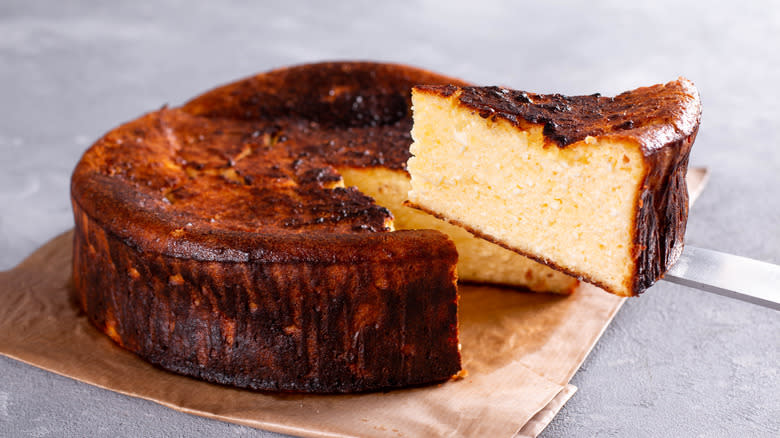The Key To A Perfectly Caramelized Basque Cheesecake Is Honey

A Basque cheesecake is defined by its dark, burnt-looking exterior. Allowing the cheesecake to look blackened may go against your baking instincts, but the technique actually creates a unique, rich flavor. While the exterior takes on a darker, crunchy crust thanks to the caramelization process, the inner cheesecake still feels soft and a little gooey.
When you're baking the cheesecake, though, there's a fine line between ensuring that the outside is caramelized, and actually burning the dessert. If the cheesecake is overbaked, the inside could wind up feeling a little too dry. Fortunately, using honey instead of sugar on the outside of the cheesecake may help make baking up the perfect Basque cheesecake a little bit easier.
Honey caramelizes a little faster than normal sugar does, according to Bee Health, an extension of the USDA. It happens at or above 160 degrees Fahrenheit, while pure sugar won't caramelize until it reaches at least 338 degrees Fahrenheit, per Science of Cooking. So if you coat the outside of your Basque cheesecake in honey, the exterior will caramelize and the interior will remain smooth and creamy.
Read more: 8 Baking Sheet Mistakes You Want To Avoid
Take Caution Not To Burn The Honey

If you're baking your cheesecake in the oven at around 300 degrees Fahrenheit, that honey will caramelize on top pretty quickly. Since that process may happen speedily, you still want to make sure the honey doesn't burn before the cheesecake is done. To find a balance between the timing of the two, you can mix equal portions of honey and sugar. Then, spread the combination over the cheesecake batter before it bakes.
Additionally, you could slightly lower the temperature of your oven. While the cheesecake may require a little extra time to bake, the reduced heat may prevent the dessert from burning. Baking the dessert slowly will also help improve the texture of the cheesecake, since the eggs in the batter won't cook up as quickly.
Once the cheesecake is done, it should still be a little wiggly in the center. Allow the cheesecake to cool down and set up, then slice through the caramelized exterior and serve.
How Will Honey Impact The Cheesecake's Flavor?

Of course, there are different types of honey, and each of them has a unique flavor that can lend itself to the cheesecake. Clover honey may taste slightly floral or like cinnamon, for example, while orange blossom honey takes on a light, citrus taste. This process could be a useful way to add an extra dimension of flavor. If you'd rather avoid any extra taste in your cheesecake, you can choose to use a more mildly flavored honey.
The resulting flavor of a Basque cheesecake — which originated in Spain — may be pretty similar to that of a crème brûlée. However, crème brûlée uses heavy cream and eggs to achieve its smooth, custard interior, and the sugar on top is caramelized after the custard bakes. Basque cheesecake, on the other hand, uses cream and cream cheese, and the caramelization occurs while the dessert bakes.
The next time you're baking up a Basque cheesecake, add a little bit of honey to the top. The sweet spread may caramelize a little faster, allowing the inner cheesecake to stay soft and smooth.
Read the original article on Daily Meal.

